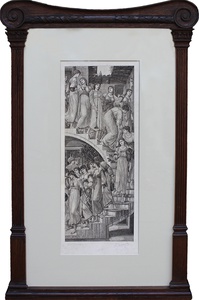| Method | Etching |
| Artist | Felix Jasinski after Sir Edward Coley Burne-Jones |
| Published | Copyright 1894 by Messrs Arthur Tooth & Sons, Publishers, 5 & 6 Haymarket, London, & 295 Fifth Avenue, New York, & Messrs Steifbold & Co. Berlin. Printed by Messrs Salmon & Ardail, Paris. |
| Dimensions | Image 640 x 270 mm, Sheet 730 x 340 mm |
| Notes |
Impression on vellum. Signed by artist and engraver. Bears PSA Stamp. The painting upon which this engraving is based is now on display at Tate Britain. The original plate is currently held at the V&A. One of Burne-Jones' best known works, The Golden Stairs was completed in 1880. It depicts a group of young women in a dream-like scene, descending a spiralling staircase. The women, all carrying instruments, are dressed in classically inspired robes in shades of gold and silver. The figures were all drawn from professional models with Burne-Jones using the faces of women from within the Pre-Raphaelite circle. The meaning of Edward Burne-Jones 'The Golden Stairs,' has been the subject of much academic debate. Some believe that the trope of the golden stair derived from Dante, and alludes to the passage of time. Though the fact that those at the bottom of the stair appear no more elderly than those at the top, may act to dispel this view. Walter Pater believed that Burne-Jones' work was representative of the concept that 'all the arts aspire to the condition of music' which is leant more credence by the fact that the figures hold instruments as they descend. The interest in investigating a mood rather than telling a story could be seen in other works of the time, most famously in Whistler's 'Nocturnes.' This style anticipated the synesthesia of art and music by groups such as the Symbolists in the late nineteenth-century. Sir Edward Coley Burne-Jones, 1st Bt (1833-1898) was a painter and designer closely associated with the later phase of the Pre-Raphaelite movement. Burne-Jones met William Morris as an undergraduate of Exeter college, Oxford, whilst studying for a degree in theology. The pair went on to work very closely together on numerous decorative arts projects including stained glass windows, tapestries and illustrations. Originally intending to become a church minister, Burne-Jones never finished his degree, choosing instead to pursue an artistic career under the influence of Dante Gabriel Rossetti. Rossetti heavily inspired his early work, but by the 1860's his idiosyncratic style was beginning to develop. His mature work, however different in total effect, is rich in conscious echoes of Botticelli, Mantegna and other Italian masters of the Quattrocento. Thusly, Burne Jones' later paintings of classical and medieval subjects are some of the most iconic of the Pre-Raphaelite movement. He was at the height of his popularity during the 1880's, though his reputation began to decline with the onset of the Impressionists. He was created a baronet in 1894, when he formally hyphenated his name. Arthur Tooth & Sons were an English print publisher and fine art dealer. Founded in London in 1842, by Arthur Tooth, the son of a framer, the firm dealt primarily in eighteenth and early nineteenth-century British paintings and etchings. In around 1880, the firm began to add contemporary paintings and occasional Old Masters to their stock. In the early 1900s, the firm opened a branch in New York and closed it in 1924. Alfred Salmon was a copper-plate printer active c.1863 - 1894. Born in 1825, he was trained by Chardonaîné at Rue Hautefeuille. He set up on his own when he took over Rémond's business in 1863. Between 1890 and 1894 he was in partnership with Adolphe Ardail (1835-1911), trading as Salmon & Ardail. In 1894 the premises at 187 Rue St Jacques were taken over by Salmon's son-in-law, and in 1895 by his grandson Alfred Louis Porcabeuf (b.1867). Condition: Professionally laid to archival board. Old glue residue staining to left lower figure area of image and to sheet edges. Area of thinning to left margin. Some staining to sheet. All predominately covered by archival mount. Framed in an ornate oak period frame. |
| Framing | framed |
| Price | £5,500.00 |
| Stock ID | 53414 |

